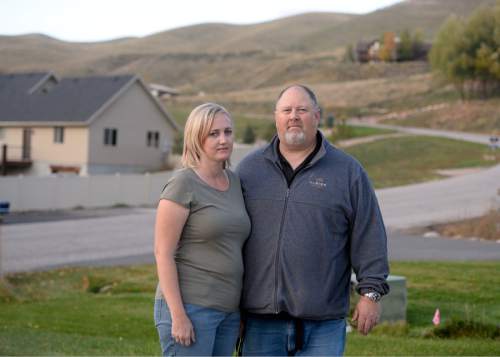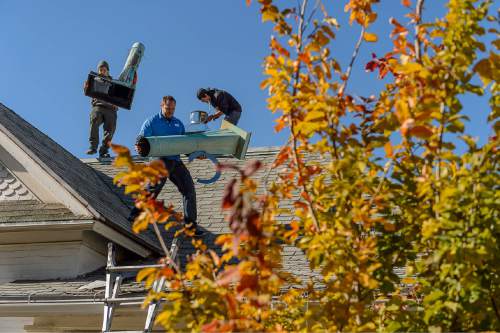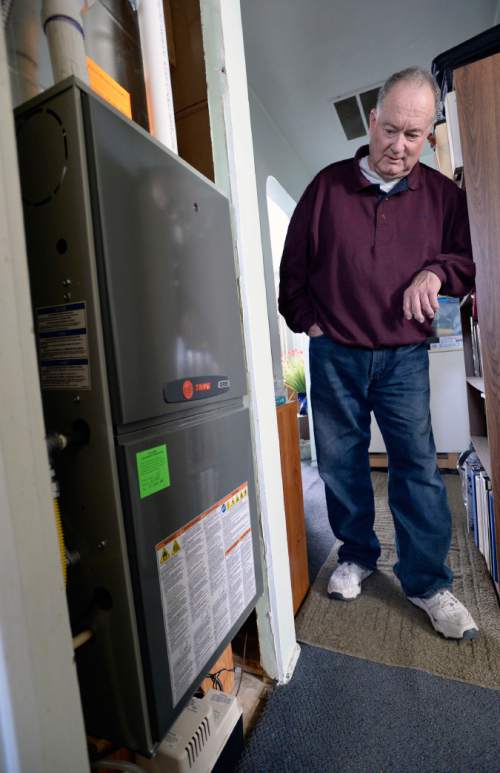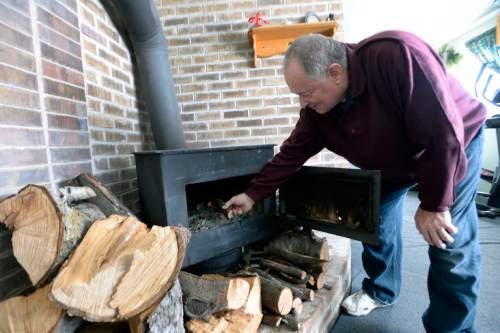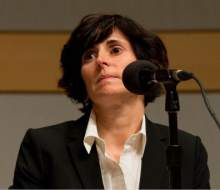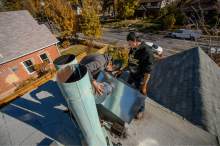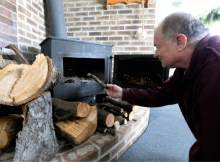This is an archived article that was published on sltrib.com in 2014, and information in the article may be outdated. It is provided only for personal research purposes and may not be reprinted.
About 37 years ago, Doug Fay's gas furnace croaked and he didn't have the money to replace it.
One thing he did have: a pile of steel plates and a friend kind and skilled enough to weld the scrap into a stove that has been heating his Kearns home ever since.
Friends who cut down trees supplied Fay with wood. He burned anything he could find — scrap pallets and coal, a relic fuel he hauled from nearby homes that had no modern-day use for it.
Through the years, Fay has spent little to heat his home. But that will change this winter, when he fires up his new furnace, installed under a program administered by Breathe Utah.
"I'm getting old enough," he said, "that I don't get excited about" hauling fuel.
Still, Fay intends to keep using his stove, just not on inversion days when pollution levels trigger the state's burn ban.
"Even if we use the new furnace regularly," he said, "something could happen that won't let you turn it on."
Fay's is among the original 207 Wasatch Front homes listed on a registry of residences that depend on solid fuels such as wood and coal as their sole source of heat. After an intensive winnowing process — weeding out second homes in the canyons, for example — and converting some of those heating systems to gas-burning furnaces, 43 homes remain on the list.
Those homeowners have a coveted status; they are the only ones exempt from the state's ban on wintertime burning. Some continue to burn because they can't afford the $5,000 price tag of a new furnace. Others are holdouts for free or low-cost wood.
The Utah Air Quality Board is considering reopening the registry so other sole sourcers can sign up for the burn-ban exemption.
But with state air quality regulators focused on ultimately reducing the tally of wood burners and improving wintertime air quality, the days of a crackling fire in the old stove may be numbered.
Wood burners on the hot seat
While state regulators believe mobile sources — cars — account for more than half the Wasatch Front's wintertime particulate problem, emissions from homes and businesses play a significant role.
Seven Utah counties stretching from Santaquin to the Idaho state line exceed federal standards for ambient levels of fine particulate matter, or PM 2.5 — particles less than 2.5 microns in diameter. The U.S. Environmental Protection Agency has set air quality limits for PM 2.5 pollution at 35 micrograms per cubic meter, a cap that is breached several times each winter along the Wasatch Front.
After years of research into the causes of the Wasatch Front's perennial wintertime inversions, wood burners have been singled out for enforcement.
There are approximately 35,000 wood-burning appliances in use in the state's urban core. And scientists have been trying to determine the extent of wood smoke's role in the region's air quality crisis, but the data do not yet paint a clear picture.
Nationally, 2.5 million households rely on wood as their main heating source, according to the U.S. Census Bureau. That number has grown by 600,000 from 2005.
The Hearth, Patio & Barbecue Association reports manufacturers shipped 54,000 pellet stoves last year and sold another 208,000 wood-burning stoves and fireplaces.
All that residential wood burning released 345,000 tons of fine particulate pollution each year, according to the EPA.
Because wood-burning appliances are "used around the clock in residential areas, they can cause significant and varying health and quality of life issues," the agency said in a recent report.
Utah's Division of Air Quality estimates a home heated with wood emits as much particulate pollution as 200 homes heated with natural gas and as many volatile organic compounds as 500 homes.
Utah Physicians for a Healthy Environment President Brian Moench testified in a trial this fall that wood smoke is even more dangerous than other pollutants.
"The particulate matter," Moench said, "is generally much smaller than pollution generated by other urban sources."
He spoke on behalf of Clayton and Martha Ericson of Morgan County, testifying that exposure to smoke leads to respiratory illnesses and triggers asthma and heart attacks. Smaller particles are more able to penetrate respiratory tissues and hang in the atmosphere longer, Moench said. But they also act as carriers for toxic chemicals and heavy metals. Burning 10 pounds of wood releases as much polycyclic aromatic hydrocarbons as 3,000 packs of cigarettes, he added.
The Ericsons sued their neighbor over the copious smoke spewing out of his outdoor wood boiler, which burned all winter, stunk up their home, made them sick and divided their neighborhood.
A 2nd District judge, however, ruled last month that the smoke did not constitute a nuisance under Utah law.
Meantime, new technology has eliminated many of the problems with older wood stoves. The EPA requires wood stoves sold today keep emissions below 7.5 grams per hour.
But about two-thirds of the 12 million stoves now in use do not comply with that standard.
Debbie Miller of Pleasant Grove has been using her wood stove for 25 years — long before EPA standards came out. She has rigged it with a device that she believes reduces emissions by combusting the smoke.
Like Fay, Miller and her family switched to wood after their gas furnace stopped working.
"With the wood, it's very warm heat," Miller said. "We start it up in October and we always keep it going all winter. It warms the whole house. There aren't hot and cold pockets."
The $5,000 cost of replacing the furnace is outside their means, but Miller said they would consider a retrofit if it were subsidized. Using gas would increase their heating costs by about $1,000. Each winter, the Millers burn about six cords of wood they purchase at the bargain price of $100 a cord. Most retailers will deliver a cord of seasoned firewood starting at around $230.
The Millers' home is on the sole-source registry, where they intend to stay.
Enforcement getting tougher
State air quality regulators consider home wood burners the low-hanging fruit in their efforts to curb wintertime emissions.
DAQ bans wood burning on days when the valleys are heading into inversions and intends to step up enforcement with the help of county health departments.
The Salt Lake County Health Department board plans to go further. On Dec. 11, it will hold a hearing on a proposal to expand the burn ban to include winter days DAQ designates for "voluntary action." In essence, burning would be barred on all but the clearest winter days.
Such a ban — if all residents comply — could cut concentrations of PM 2.5 by up to 2 micrograms, a significant reduction, according to Dave McNeill, planning branch manager for the DAQ.
Last year, the state issued 54 violations, two going to repeat offenders, according to Jay Morris, a DAQ compliance manager. First-time offenders get a $25 civil fine, $150 for a second violation and the $299 maximum after that.
County personnel this year will do the field work of investigating complaints, talking to offending homeowners and documenting violations, while the state will process the paperwork.
The counties' role "is education focused," said Gary Edwards, executive director of the Salt Lake County Health Department. "If additional complaints come in, we have to get evidence of burning. But it's difficult if they aren't burning during the day. Our focus is not to find people actually doing, but preventing it from happening."
Most observers say casual burners play a bigger role in Utah's particulate problem — there simply are more of them.
University of Utah chemical engineer Kerry Kelly studies the fine particles collected on filters at state air monitoring stations. The particles' chemical signatures reveal the fuel source where they started. Based on that analysis, Kelly believes wood smoke is to blame for about 5 percent of the particulate pollution in Utah's population centers.
And Moench's group has pressed Utah regulators to toughen rules on wood burning and consider a full ban during inversion season.
The Air Quality Board hasn't gone that far. But at their Dec. 3 meeting, board members will consider extending residential burn restrictions to commercial operations and institutions. The change would cover the two fireplaces in the Utah Capitol, but exempt restaurants, including several pizzerias that use wood-fired ovens to bring savory Italian cuisine to Salt Lake City.
"As a society, we are OK with some pollution if it's for delicious food," said Matt Pacenza of HEAL Utah, another clean-air advocacy group.
He considers the state's investment in retrofitting sole-source homes shortsighted.
"For everyone [burning] around the clock, there are 100 doing it for an hour," Pacenza said. "We should make them think twice every time they buy wood. Mandate signage at places that sell wood and don't sell wood on no-burn days."
But John Crouch, public affairs director for the Hearth, Patio & Barbecue Association, argues Utah is not following the lead of other Western states that have tackled wood-burning pollution.
The association advocates a two-stage, mandatory no-burn policy. The first stage would ban burning in conventional and coal stoves and wood-burning fireplaces as an inversion sets in. The second stage, once an inversion lingers, would cut off burning in gas fireplaces and EPA-certified wood stoves.
And, Crouch added, Salt Lake County's move to block burning on even more winter days, goes too far. Instead, he said, the county could accomplish more with an incentive-based approach, like two-stage no-burn policies that reward homeowners who have installed newer stoves.
"We look forward to a time when the Wasatch Front communities come out of this approach that if we just tell people they're stupid to burn wood, they won't," Crouch said. "Maybe it will work there, but I don't think so."
The burning habit
The state and private sector have stepped in with grants to help homeowners who want to switch out old wood-burning stoves. But getting Utahns to reduce reliance on preindustrial fuel has proven to be a challenge.
The state sent letters to all 52 residents who received burn violations last winter, informing them of subsidies for retrofits, but none responded, according to DAQ's Morris.
"It is difficult for some people to switch. Some live off the grid. Do you want them to switch to propane, which can be dangerous?" said Ted Wilson, UCAIR executive director. "For some it is cultural. They take pride in getting a BLM permit and chopping wood [on public land] and bringing it home."
A public-private partnership aimed at improving air quality, UCAIR is using a $30,000 grant from the Utah Association of Realtors to help residents replace wood-burning stoves with gas-fired appliances.
Chris Binger and Allison Locatelli, who bought their turn-of-the-century home in Salt Lake City's Ninth and Ninth neighborhood five years ago, are one couple taking advantage of the incentive. The UCAIR grant, available to those not on the sole-source registry, covered 75 percent of the $3,500 cost to replace an old stove that heated their bedroom in a renovated part of the house not served by its forced-air furnace.
The couple liked the quality of the heat and used it only on cold nights — except during inversions.
"I like the ambiance. It's a selling feature of the house to have another fireplace," Binger said. "The hard part is, we weren't allowed to use it when it's coldest. We would have two, three blankets on the bed."
They burned wood they got for free when old neighborhood trees came down. But the stove pulled cold air into the room from outside.
Their new, high-tech Jotul unit, however, draws air into the firebox through the exterior part of the flue, making it far more efficient. And flames still show through the door so they can enjoy the flicker every night.
While contractor Mike Gunter was in their home last week, the couple also had him install a gas-fired insert in the main fireplace. On their own dime.
What's next?
O Dec. 3 • The Utah Air Quality Board will consider extending residential burn restrictions to businesses and institutions. Restaurants would be exempt, but not the two fireplaces at the state Capitol.
Dec. 11 • The Salt Lake County Department of Health will hold a hearing on a plan to expand the burn ban to include winter days DAQ designates for "voluntary action." Wood-burning would be prohibited on all but the clearest winter days.


